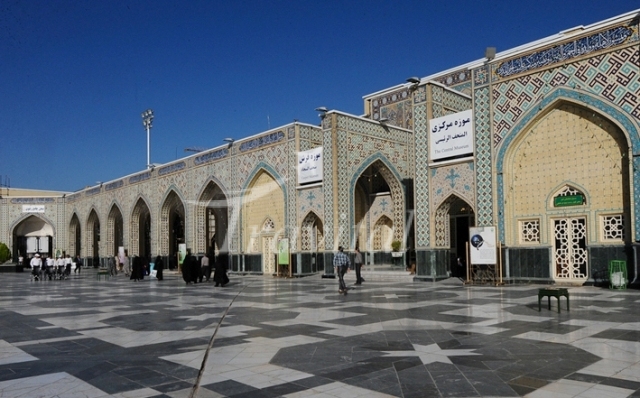Astan-e-Qods Razavi Aggregate – Mashhad



Overview
This forms the axis of the holy city of Mashad and is one of the most important and greatest ‘aggregates’ in the world of Islam. Its importance is due to the presence of the shrine of His Holiness Imam Reza (AS), 148-203 AH, which contains valuable historical and artistic monuments from various centuries. History of Construction: In the year 203 AH, or as it is said, in the year 202 AH, after the martyrdom of His Holiness Imam Reza (AS), the sacred body was laid to rest on the tomb of Haroon-ol Rashid. It is said that Moqadasi was the first person to name the place Mashad (meaning the place of martyrdom). Ibn-e-Hogol has also called it ‘Mashad-ol-Reza’. In the years 366-387 AH the biased Sabkat Keen one of the rulers of the Qaznavi era, brought down the Holy Shrine to ruins and forbade pilgrimage to the sacred place. Thence, Abaidodowleh Fa'eq endeavored to complete the task of rebuilding the mausoleum and has made great efforts in making the city of Mashad flourish.Thereafter Sultan Mohammad Qaznavi built a brick wall on the former mud caked wall and erected a minaret as well. According to the inscription in the museum of the shrine it seems that the building was repaired again in 516 AH. In the year 548 AH, the mausoleum was heavily damaged due to the attack of the Qazhs. During the reign of Sultan Sanjar Saljuqi 552-511 AH, the Shrine was once more repaired, and a dome built for the same. The daughter of Sultan Sanjar, (whose name and date of contribution is on record on the inscriptions) was responsible for paving the area surrounding the Shrine in geometrical and star (hexa and octagonal) shaped tiles which added to their beauty. The reign of Kharazmshahian has also brought about various repairs and artistic measures in the mausoleum. In the year 612 AH, a beautiful embossed inscription on a caked tablet, fixed to the wall on both sides of the entrance to the Shrine, which is in the Tholth script indicates the names of ancestors of His Holiness Imam Reza (AS), originating from His Holiness Hazrat-e-Ali (PBUH). After the attack of ‘Towli’ the son of Changis, in the year 618 AH, the mausoleum of Razavi was shattered once again, and later on Qazan Khan and Sultan Mohammad Khodabandeh Oljaito made efforts for repairs and artistic works of the Garden or (Baq) Razavi. In the year 734 AH, Ebn-e-Batooteh a reputed historian, had made special mention of the beautiful and tile worked edifice with the silver railed shrine in his records. In the 8th century the Astan-e-Qodes was composed of the shrine, the Balasar mosque, a few smaller buildings attached to northern wall of a school. During the reign of Shahrokh and his spouse Goharshad the aggregate made great progress and vast development was noted. The Goharshad mosque was erected to the direction of the kiblah of the shrine. Then buildings known as Darolhefaz, Darolsiadeh and Tahvil Khaneh (treasury) were erected. Three schools by the names of Parizad, Balasar and Dodar were also erected during this epoch. Due to the endeavors of Amir Alishir Navai the old courtyard, and the basis of the Evan-e-Tala or golden portico came into focus. Further more, in the period of Shah Abbas I it was extended to a great deal. Shah Tahmasb Safavid repaired the minaret near the dome which was then gold plated. But unfortunately due to the attack of the Ozbaks, these ingots of great value were plundered, an in the year 1010 AH, Shah Abbas ordered the repairs of this edifice. This decree is on one of the carvings by the famous calligrapher Ali Reza Abbasi. It should be brought to attention that the said mausoleum vastly expanded due to additions during the passage of time-such as the Ravaq or Porch of Towhid Khaneh (to the north of the shrine) is by the efforts of Molla Mohsen Faiz, Ravaq-e-Allahverdi Khan and Ravaq-e-Hatam Khani are likewise erected by Allahverdi Khan and Hatem Bek Ordubadi. Shah Abbas II was responsible for the repairs of the Attiq courtyard which was inlayed with tiles and Shah Soleiman gave orders for the repair of the dome of the holy shrine which had a crack due to an earthquake. In addition to which, many schools were built during his reign.
See more in Mashhad
Mashhad Hotels
Your Travel Journey Starts Here
Sign up and we'll send the best deals to you

